The term ______ variation refers to differences in specific genes.
Multiple choice question.
aneuploid
allelic
genetic
allelic
A cytogeneticist ______.
Multiple choice question.
examines DNA mutations
studies chromosomes microscopically
studies the origins of cells
examines RNA levels
studies chromosomes microscopically
Which of the following statements about the chromosome number in humans and fruit flies is true?
Multiple choice question.
Humans have 40 chromosomes, while fruit flies have 20 chromosomes
Humans have 40 chromosomes, while fruit flies have 8 chromosomes
Humans have 46 chromosomes, while fruit flies have 20 chromosomes
Humans have 46 chromosomes, while fruit flies have 8 chromosomes
Humans have 46 chromosomes, while fruit flies have 8 chromosomes
Match the chromosome to its appropriate description.
Metacentric
Submetacentric
Acrocentric
Telocentric
Its centromere is at one end
Its centromere is near the middle
Its centromere is slightly off center
Its centromere is significantly off center but not at the end
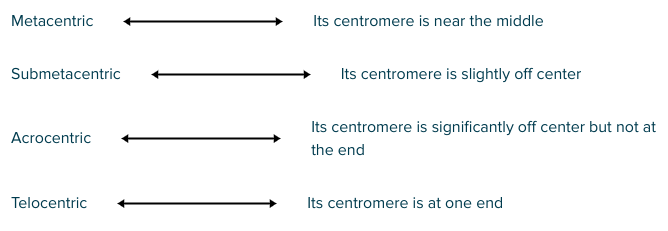
- Metacentric Its centromere is near the middle
- Submetacentric Its centromere is slightly off center
- Acrocentric Its centromere is significantly off center but not at the end
- Telocentric Its centromere is at one end
The short arm and long arm of a chromosome are designated with ______, respectively.
Multiple choice question.
the letters s and l
the letters p and q
the numbers 2 and 1
the letters q and p
the numbers 1 and 2
the letters p and q
Genetic differences within individuals of the same species or between different species is referred to as genetic ____.
variation
An organized representation of the chromosomes of a cell is called a ______.
Multiple choice question.
karyotype
phenotype
haplotype
genotype
karyotype
A scientist who examines the chromosomal composition of a particular cell is called a(n) ___.
cytogeneticist
G banding is a procedure in which chromosomes are ______.
Multiple choice question.
treated with stains to produce dark and light bands dependent on the compaction of their DNA
treated with high heat and DNAses to produce smaller bands whose DNA is easier to sequence
treated with chemicals that hydrolyze the proteins leaving DNA bands that are easier to study microscopically
treated with stains to produce dark and light bands dependent on the compaction of their DNA
Normal somatic cells of a human have a total of ____ chromosomes, whereas those of a fruit fly contain a total of ____ chromosomes.
46; 8
Select all that apply
The banding pattern of eukaryotic chromosomes is useful for which of the following reasons?
Multiple select question.
To distinguish between chromosomes of the same size
To detect changes in chromosome number
To detect changes in chromosome structure
To assess evolutionary relationships between species
To distinguish between chromosomes of the same size
To detect changes in chromosome structure
To assess evolutionary relationships between species
Chromosomes are classified into four types based on their centromere location: 1. ____ (the centromere is near the middle); 2. ____ (the centromere is slightly off center); 3. ____ (the centromere is closer to the end than to the center); and 4. ____ (the centromere is at one end).
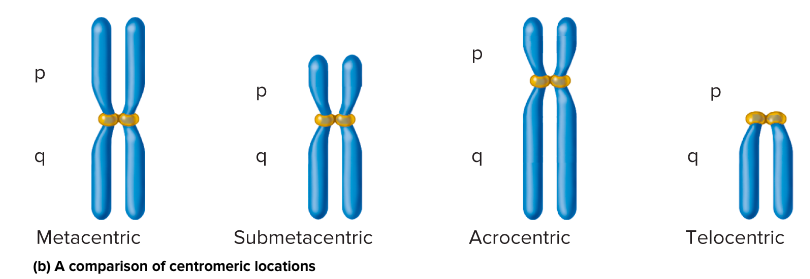
Blank 1: Metacentric
Blank 2: Submetacentric
Blank 3: Acrocentric
Blank 4: Telocentric
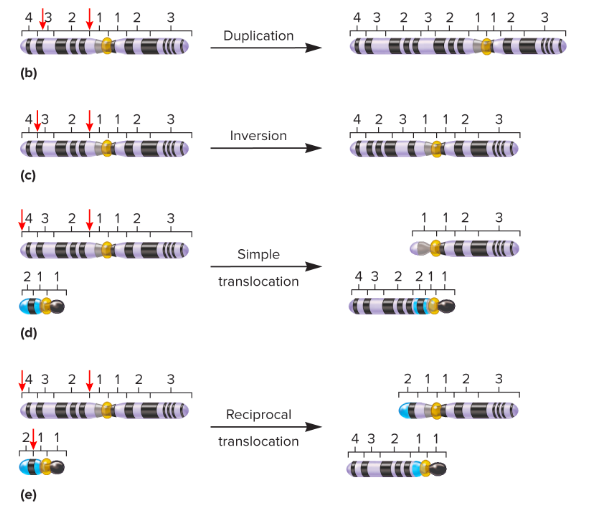
Match the change in chromosome structure to its appropriate description.
Duplication
Deficiency
Inversion
Translocation
The loss of a chromosome segment
The movement of a chromosome segment
The change in direction of a chromosome segment
The addition of a chromosome segment
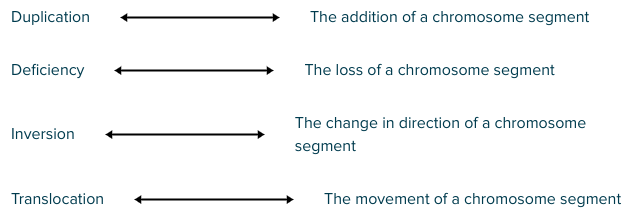
- Duplication The addition of a chromosome segment
- Deficiency The loss of a chromosome segment
- Inversion The change in direction of a chromosome segment
- Translocation The movement of a chromosome segment
A chromosome typically has a short arm (designated by the letter ____) and a long arm (designated by the letter ____).
p ; q
A change in chromosome structure where a portion of the chromosome is missing is called a(n) ____.
deletion, deficiency, or deletions
A(n) ____ is a micrograph which displays the chromosomes of a cell, usually in descending order of size.
karyotype or karyogram
A change in chromosome structure where a portion of the chromosome is repeated is called a(n) ____.
duplication
Which of the following statements is true about a chromosome that has been subjected to the G banding technique?
Multiple choice question.
It has the short arm stained, but not the long arm.
It has the long arm stained, but not the short arm.
It shows alternating patterns of dark and light regions.
It has the centromere and telomere stained, but not other parts.
It shows alternating patterns of dark and light regions.
If a segment of DNA changes orientation along the chromosome, a(n) ____ is said to have taken place.
inversion
Because they show different banding patterns when stained, chromosomes that have the same ____ and ____ location can be distinguished from each other.
Blank 1: size, length, sizes, or lengths
Blank 2: centromeric or centromere
The movement of a DNA segment from one chromosome to another is an example of a(n) ______.
Multiple choice question.
transformation
duplication
translocation
inversion
translocation
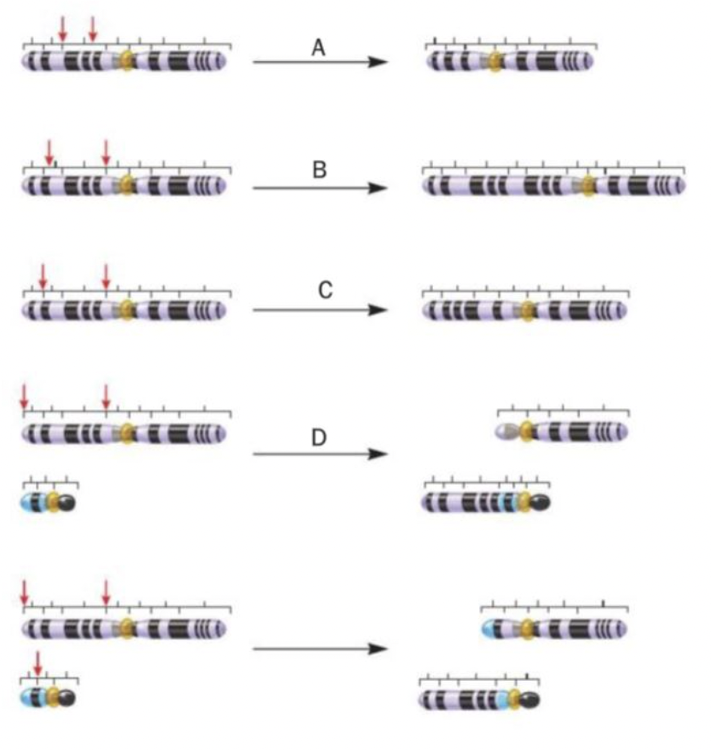
This diagram depicts the four main types of changes in chromosome structure. A = ____; B = ____; C = ____; and D = ____ (two chromosomes are involved).
A: deletion
B: duplication
C: inversion
D: translocation
A deletion is best defined as the loss of ______.
Multiple choice question.
a chromosome segment
an entire chromosome
either the centromere or a telomere
one of the two chromosome arms
a chromosome segment
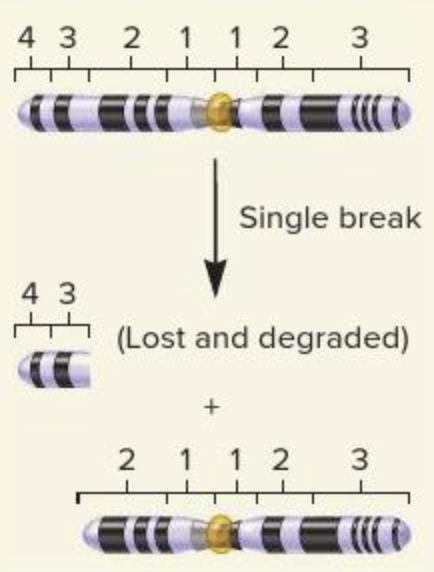
This illustration shows the production of a(n) ______.
Multiple choice question.
terminal deletion
pericentric inversion
reciprocal translocation
paracentric inversion
interstitial deletion
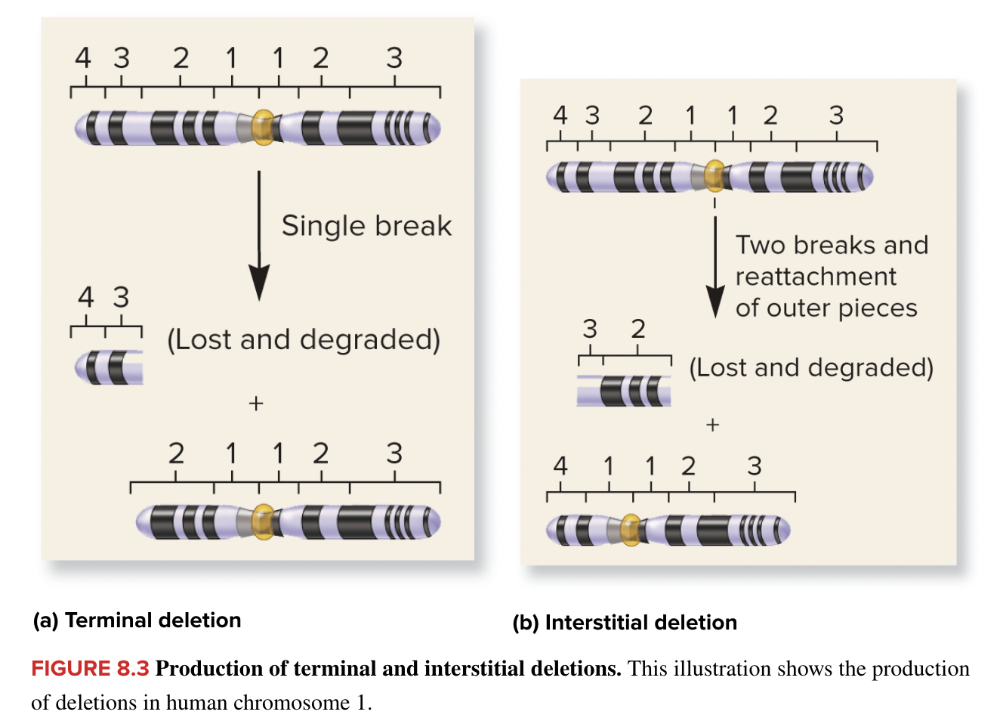
terminal deletion
A duplication is best defined as the addition of ______.
Multiple choice question.
either the centromere or a telomere
one of the two chromosome arms
an entire chromosome
a chromosome segment
a chromosome segment
Consider a chromosome that has broken in two places to produce three chromosomal fragments. The middle fragment is lost and degraded. The rejoining of the two outer fragments will create a chromosome with a(n) ____ deletion.
interstitial
A reversal of the order of genes along a chromosome is termed a(n) ______.
Multiple choice question.
translocation
duplication
inversion
deletion
inversion
Individuals with a chromosome 5 that is missing part of its short arm may have a disease called ____-____-____ syndrome.
Blank 1: cri
Blank 2: du
Blank 3: chat
A change in chromosome structure in which a segment of DNA becomes attached to another part of the same chromosome or to a different chromosome is called a(n) ____.
translocation
Identical or similar DNA sequences that occur multiple times on a chromosome are called ____ sequences.
repetitive
Nonallelic homologous recombination between two chromosomes leads to ______.
Multiple choice question.
two chromosomes each carrying a duplication and a deletion but of different genes
a chromosome carrying an inversion and another carrying a translocation
two chromosomes each carrying an inversion and translocation, but of different genes
a chromosome carrying a duplication and another carrying a deletion
a chromosome carrying a duplication and another carrying a deletion
Consider a normal chromosome that has broken into two separate pieces, one of which is lost because it lacks a centromere. The resultant chromosome is said to have undergone a(n) ____ deletion.
terminal
A chromosome in which the number of copies of a gene increases from one to two is said to have a gene ____.
duplication
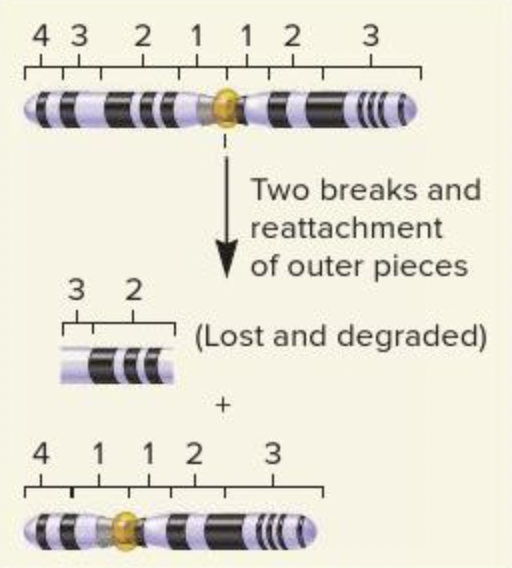
This figure illustrates a(n) ______.
Multiple choice question.
pericentric inversion
terminal deletion
interstitial deletion
paracentric inversion
reciprocal translocation

interstitial deletion
Cri-du-chat syndrome is caused by a ______.
Multiple choice question.
deletion in the short arm of chromosome 5
duplication in the long arm of chromosome 18
deletion in the short arm of chromosome 18
duplication in the long arm of chromosome 5
deletion in the short arm of chromosome 5
Which of the following statements about the phenotypic effects of deletions and duplications is true? Assume the changes are of comparable size.
Multiple choice question.
Duplications are less likely to have harmful effects than deletions.
Duplications are more likely to have harmful effects than deletions.
Duplications and deletions tend to have the same level of harmful effects.
Duplications are less likely to have harmful effects than deletions.
Transposable elements are examples of ______.
Multiple choice question.
terminal deletions
reciprocal translocations
pericentric inversions
repetitive sequences
repetitive sequences
Charcot-Marie-Tooth disease (type 1A) is caused by a small ______ on the short arm of chromosome 17.
Multiple choice question.
deletion
translocation
inversion
duplication
duplication
A misalignment of repetitive sequences on two chromosomes can cause an abnormal crossover to happen. This is called ____ ____ recombination, and it results in one chromatid carrying a duplication and another containing a deletion.
nonallelic homologous
A gene family is a set of genes ______.
Multiple choice question.
in different species that are identical to each other
that are shared by a group of unrelated individuals
that are shared by a group of related individuals
in a particular species that are similar to each other
in a particular species that are similar to each other
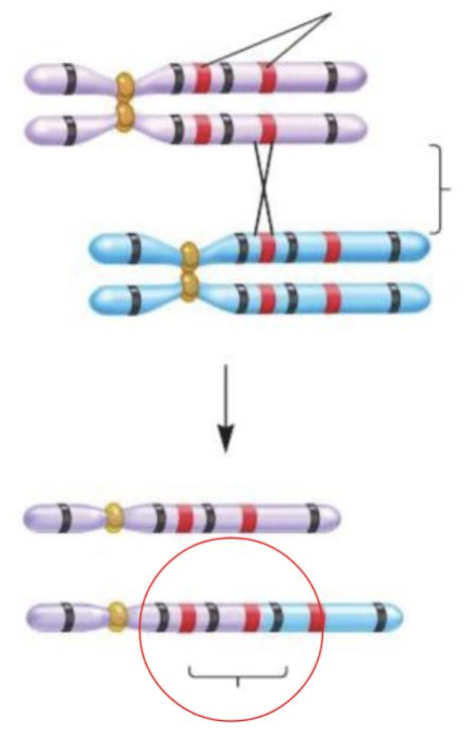
In this figure, the bracket (circled) is used to highlight a gene ______.
Multiple choice question.
inversion
deletion
translocation
duplication
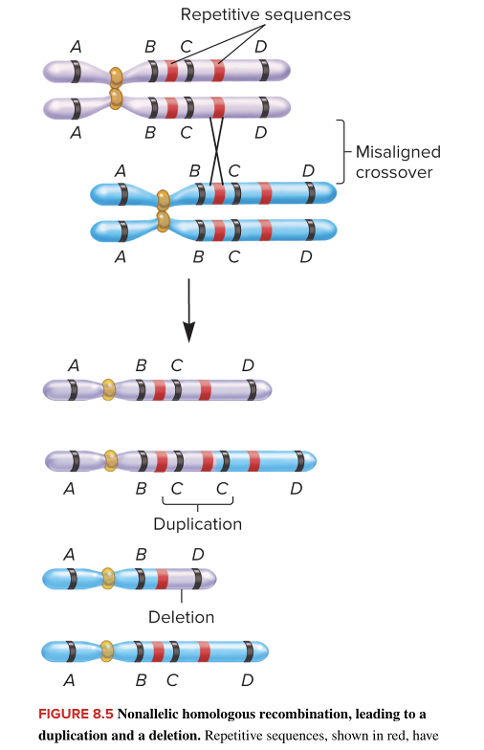
duplication
Homologous genes are those ______.
Multiple choice question.
that have identical DNA sequences
derived from a single parent
that share common promoter sequences
derived from a single ancestral gene
derived from a single ancestral gene
In a single species, homologous genes are called ____ and collectively make a gene family.
paralogs
In general, having only a single copy of a gene is ______ having three copies.
Multiple choice question.
less harmful than
more harmful than
as harmful as
more harmful than
The globin gene family in humans is composed of 14 ______ that encode polypeptides whose function is to ______.
Multiple choice question.
orthologs ; contract muscles
orthologs ; bind oxygen
paralogs ; contract muscles
paralogs ; bind oxygen
paralogs ; bind oxygen
Which of the following syndromes is caused by a duplication?
Multiple choice question.
Charcot-Marie-Tooth disease
Cri-du-chat syndrome
Edwards syndrome
Tay-Sachs disease
Charcot-Marie-Tooth disease
A collection of two or more genes in a particular species that are similar to each other is known as a gene ____.
family
The globin gene family is dispersed on chromosome ______ and chromosome ______.
Multiple choice question.
11 : 16
1 : 2
2 ; 4
X ; Y
11 : 16
Two or more genes that are derived from the same ancestral gene are referred to as ____ genes.
homologous
____ is specialized to bind and store oxygen in the muscle while ____ is specialized to bind and transport oxygen in the red blood cells.
myoglogin; hemoglobin
Paralogs are homologous ______.
Multiple choice question.
genes in different species
genes within the same species
chromosomes within the same species
chromosomes in different species
genes within the same species
In humans, the embryonic and fetal forms of hemoglobin have a higher affinity for oxygen than that of adults. This is due to ______.
Multiple choice question.
identical genes that generate a large number of ribosomes needed for globin production before birth
pseudogenes that interfere with gene expression in adults
homologous genes that produce different versions of globins during development
homologous genes that produce different versions of globins during development
One of the most important examples of gene families in humans is the ____ gene family, whose protein products play roles in oxygen binding.
globin
Copy number variation (CNV) describes DNA segments of at least ______ in size which exhibit copy number differences among members of ______.
Multiple choice question.
100 bp ; the same species
1,000 bp ; the same species
1,000 bp ; different species
100 bp ; different species
1,000 bp ; the same species
Select all that apply
Copy number variations may involve which of the following?
Multiple select question.
Duplications
Translocations
Inversions
Deletions
Duplications
Deletions
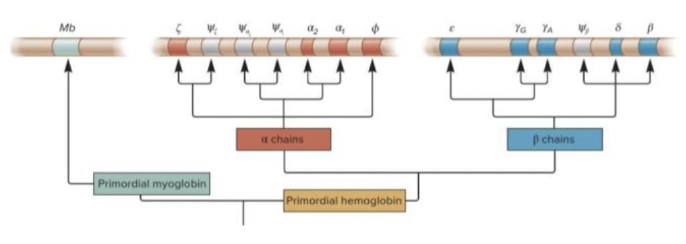
This figure shows the ______ gene family.
Multiple choice question.
tubulin
globin
actin
calmodulin
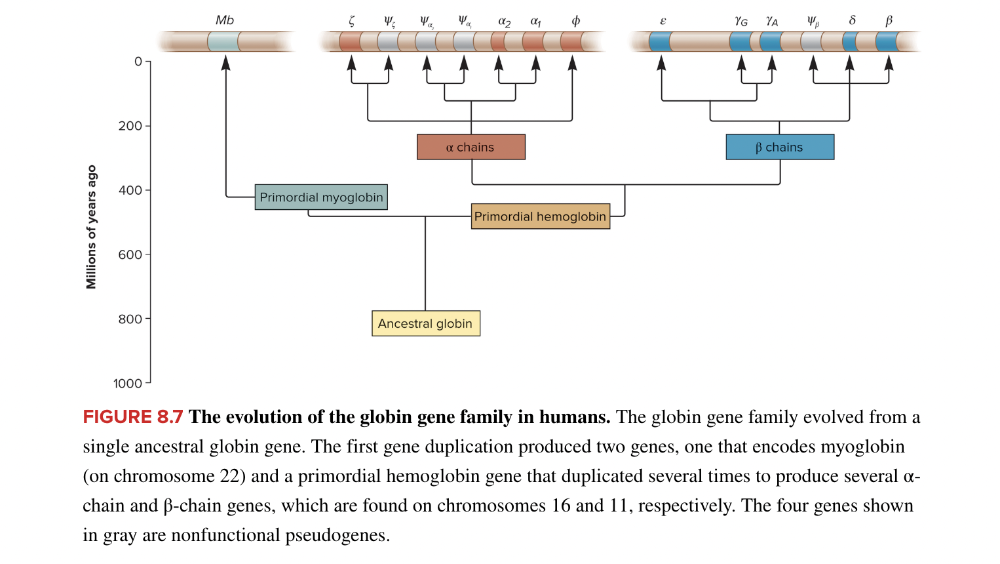
globin
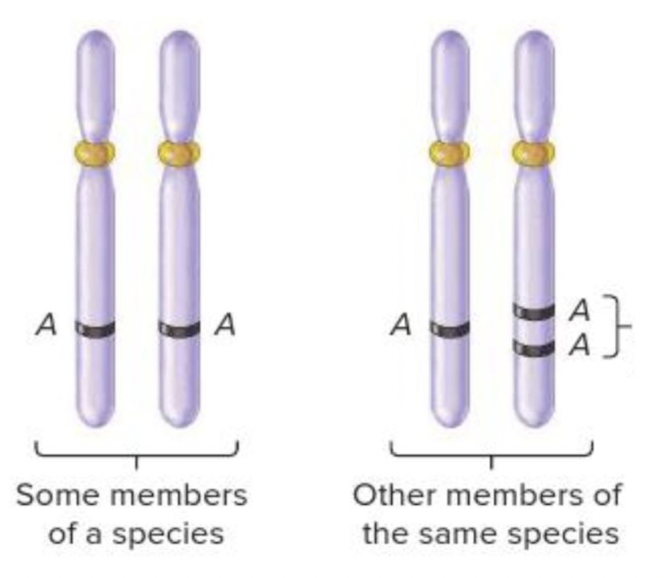
In this figure, the bracket is used to highlight a ______.
Multiple choice question.
terminal duplication
gene triploidy
segmental duplication
gene trisomy
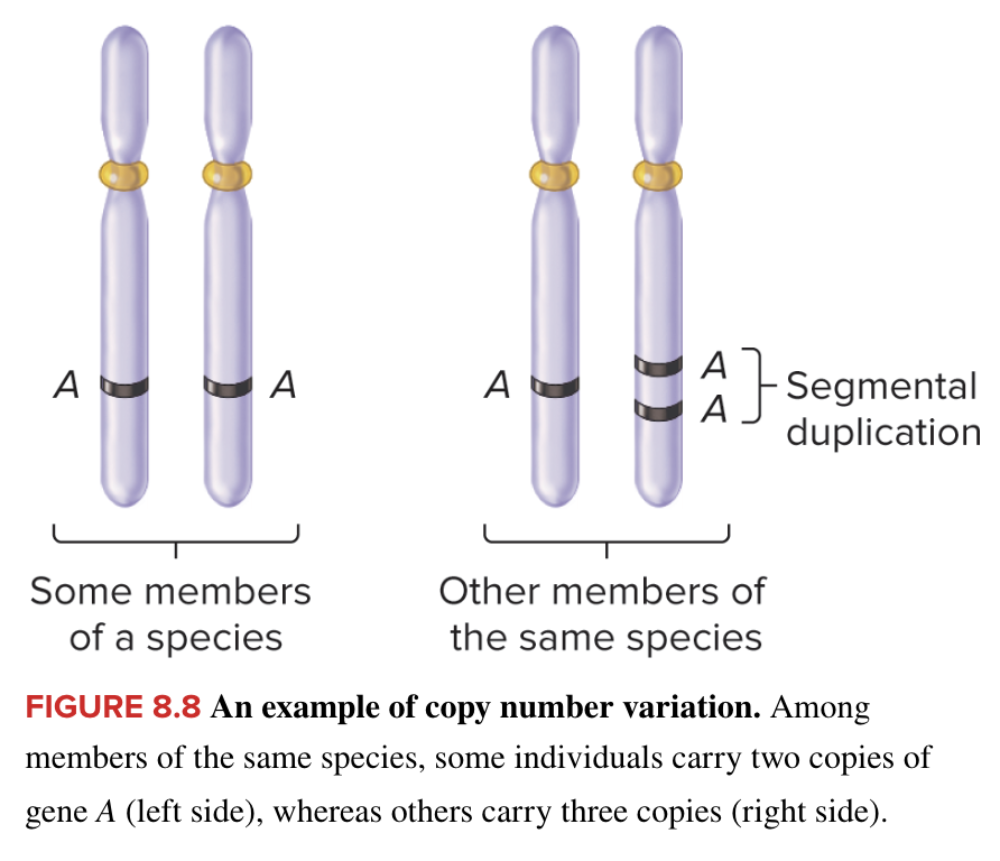
segmental duplication
Globin proteins are specialized in their function. For example, ____ is used to bind and store oxygen in muscle cells, while ____ is better suited for red blood cells.
myoglobin; hemoglobin
Copy number variations typically account for approximately ______ of the difference in the genomes of two unrelated humans.
Multiple choice question.
10%
0.4%
0.1%
40%
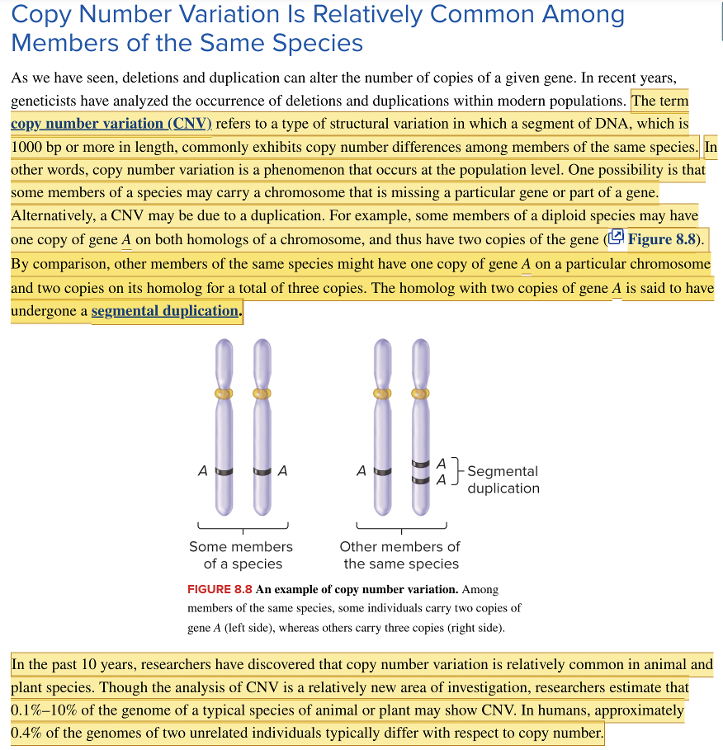
0.4%
The hemoglobin in humans exists in how many main types?
Multiple choice question.
Two types: Child and adult
Two types: Before birth and after birth
Three types: Fetal, child, and adult
Three types: Embryonic, fetal, and after birth
Three types: Embryonic, fetal, and after birth
True or false: All copy number variations found in humans are known to be associated directly or indirectly with genetic or infectious diseases.
True false question.TrueFalse
False
DNA segments of 1000 bp or more in length which exist in differing numbers of copies among individuals within the same species are described by the term ____ ____ ____ (CNV).
copy number variation
Select all that apply
Comparative genomic hybridization is a method that can be used to detect what changes in chromosome structure?
Multiple select question.
Translocations
Deletions
Duplications
Inversions
Deletions
Duplications
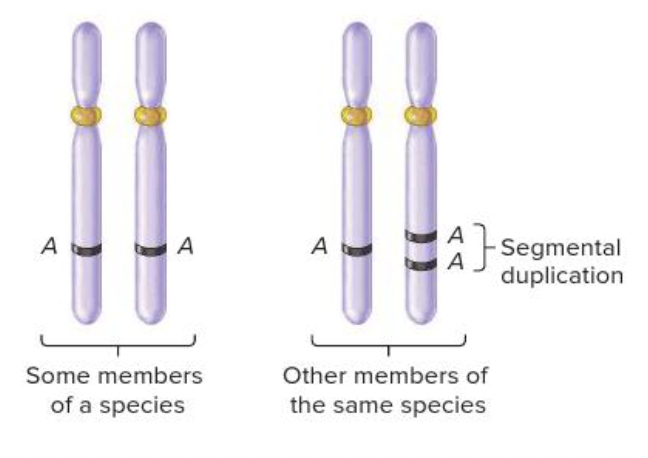
This figures illustrates what phenomenon?
Multiple choice question.
Chromosome nondisjunction
Gene trisomy
Misaligned crossing over
Copy number variation

Copy number variation
The process which involves the formation of a double-stranded DNA molecule from single-stranded DNA molecules of two different samples is termed ____.
hybridization
Consider a homologous pair of chromosomes of a particular individual, where one homolog carries a single copy of gene A while the other carries two copies of the same gene. The latter chromosome is said to have undergone a(n) ____ ____.
segmental duplication
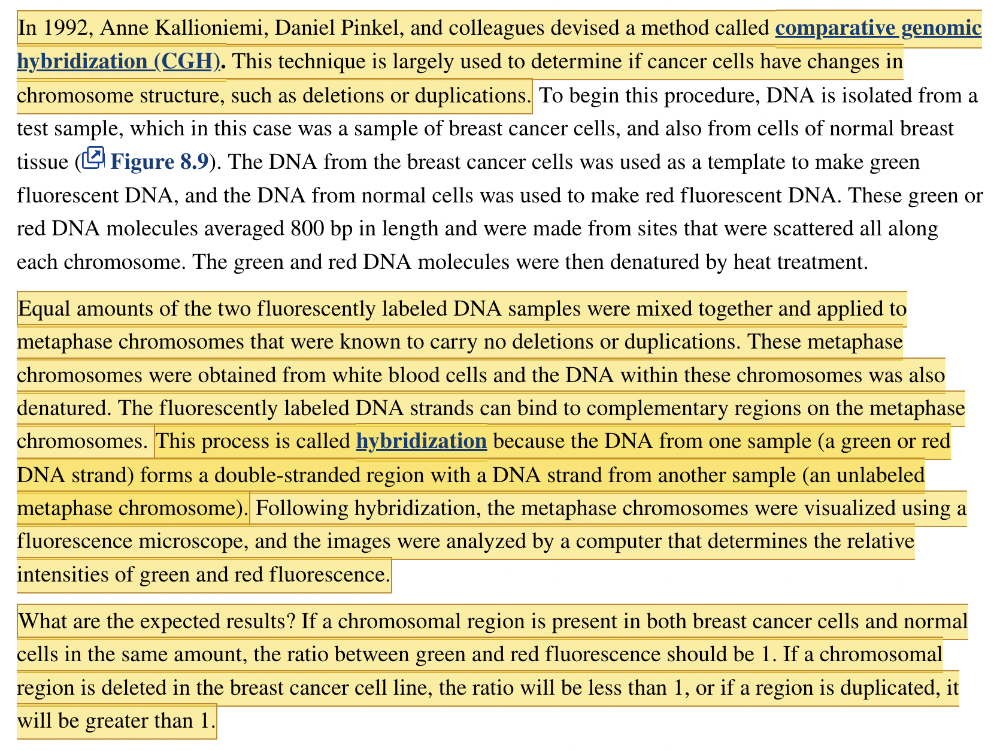
Which of the following is not a step used in the comparative genomic hybridization technique?
Multiple choice question.
the chromosomes are visualized with a fluorescence microscope and the degree of fluorescence is analyzed with a computer
DNA is differentially-labeled using a red and a green fluorescent molecule
DNA is isolated from two different types of cancer cells
the fluorescently-labeled DNA is denatured by heat treatment
a mixture of fluorescently-labeled DNA is allowed to hybridize to metaphase chromosomes obtained from white blood cells
DNA is isolated from two different types of cancer cells
Select all that apply
Copy number variations are relatively common in the genomes of which of the following?
Multiple select question.
Plants
Bacteria
Archaea
Viruses
Animals

Plants
Animals
In a comparative genomic hybridization experiment, the ratio of green to red fluorescence was 2. This indicates that a particular chromosome carries a(n) ____.
duplication
In humans, individuals with a higher copy number of the gene CCL3 produce more ______ protein, and thus tend to be more ______.
Multiple choice question.
calmodulin ; resistant to AIDS
chemokine ; resistant to AIDS
calmodulin ; sensitive to cancer
chemokine ; sensitive to cancer
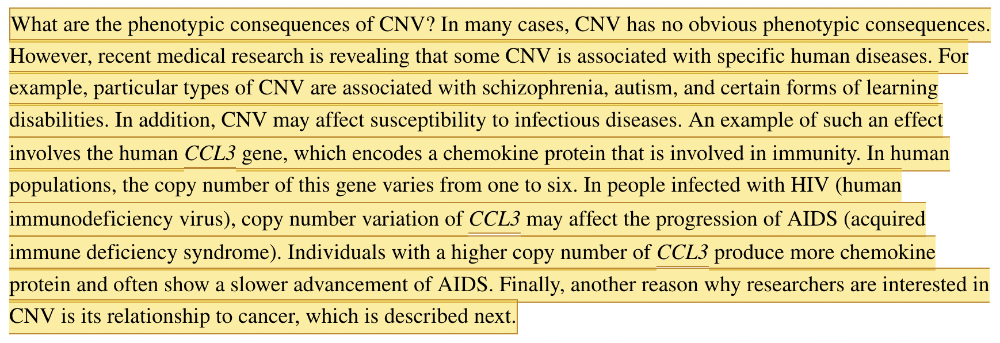
chemokine ; resistant to AIDS
A technique called ____ ____ (CGH) can be used to determine whether a cancer cell has changes in chromosome structure, such as duplications or deletions.

comparative genomic hybridization
A chromosomal structural change in which a segment of DNA is rotated 180o is referred to as a(n) ____.
inversion
The DNA from one source forms a double-stranded region with the DNA from another source during what process?
Multiple choice question.
Hybridization
Recombination
Translocation
Fusion
Hybridization
Inversions are classified into two types. In a(n) ____ inversion, the centromere lies within the inverted region of the chromosome, while in a(n) ____ inversion, the centromere is located outside the inverted region.
pericentric; paracentric
List the steps of comparative genomic hybridization in order. Start with the earliest on top.
Isolate DNA from human breast cancer cells and normal breast cells.
Mix together heat-denatured fluorescently labeled DNA and metaphase chromosomes from white blood cells (also denatured).
Label the breast cancer DNA with a green fluorescent molecule and the normal DNA with a red fluorescent molecule.
Allow the fluorescently labeled DNA to hybridize to the metaphase chromosomes.
Visualize the chromosomes with a fluorescence microscope. Analyze the amount of green and red fluorescence along each chromosome with a computer.

1) Isolate DNA from human breast cancer cells and normal breast
cells.
2) Label the breast cancer DNA with a green fluorescent
molecule and the normal DNA with a red fluorescent molecule.
3)
Mix together equal amounts of heat-denatured fluorescently labeled
DNA.
4) Allow the fluorescently labeled DNA to hybridize to the
metaphase chromosome.
5) Visualize the chromosomes with a
fluorescence microscope. Analyze the amount of green and red
fluorescence along each chromosome with a computer.
Steps of comparative genomic hybridization:

1) Isolate DNA from human breast cancer cells and normal breast
cells.
2) Label the breast cancer DNA with a green fluorescent
molecule and the normal DNA with a red fluorescent molecule.
3)
Mix together equal amounts of heat-denatured fluorescently labeled
DNA.
4) Add DNA to a preparation of metaphase chromosomes from
white blood cells (which has also been denatured).
5) Allow the
fluorescently labeled DNA to hybridize to the metaphase
chromosome.
6) Visualize the chromosomes with a fluorescence
microscope. Analyze the amount of green and red fluorescence along
each chromosome with a computer.
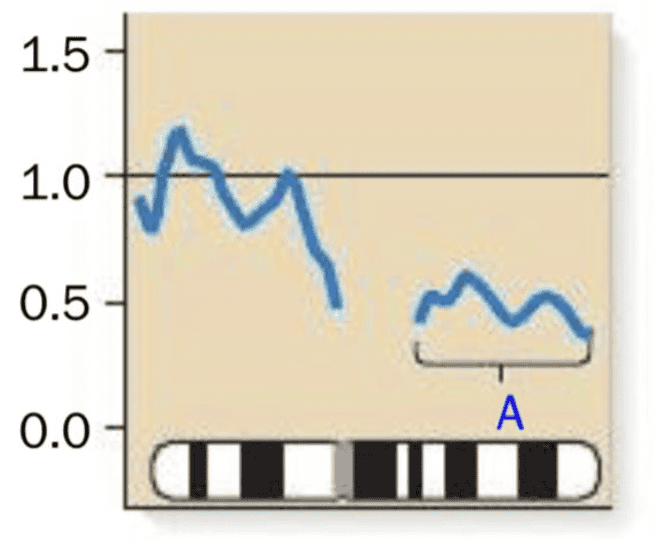
The graph shows the ratio of green to red fluorescence along metaphase chromosome 16 of humans. The region of the chromosome that is labeled A carries a(n) ______.
Multiple choice question.
inversion
deletion
translocation
duplication
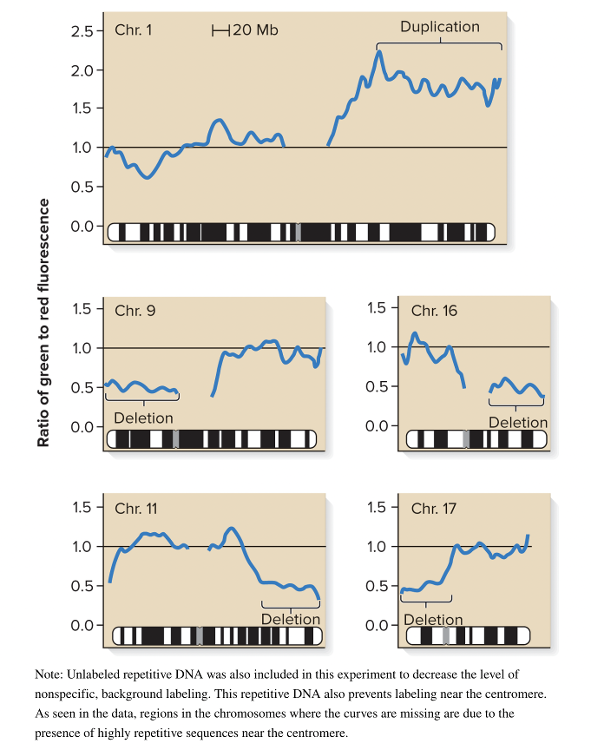
deletion
Hemophilia type A can be caused by an inversion that has disrupted the gene for ______.
Multiple choice question.
hemoglobin alpha
factor Y
factor VIII
hemoglobin beta
factor VIII
a blood-clotting protein
A change of phenotype that results from a change in the chromosomal location of a gene is called a(n) ____.
position effect
Inversions are classified based on what characteristic?
Multiple choice question.
The type of cell
The type of chromosome
The position of the telomere
The position of the centromere
The position of the centromere
The great majority of inversions do not cause phenotypic consequences because ______.
Multiple choice question.
the genes are transferred between homologous chromosomes
inversions occur in chromosome regions that do not contain genes
the total amount of genetic material does not change in a given chromosome
the total amount of genetic material does not change in a given chromosome
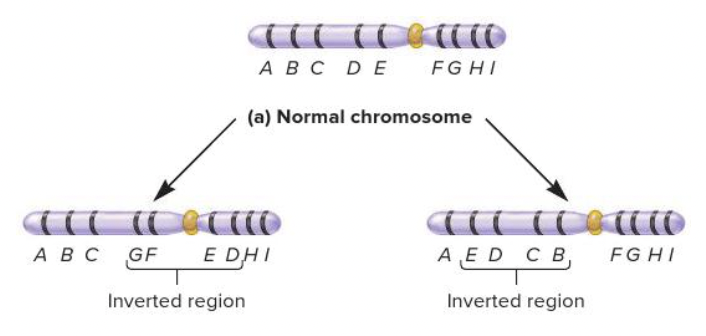
This figure illustrates the types of chromosomal inversions. The left panel depicts a(n) ____ inversion, and the right panel shows a(n) ____ inversion.
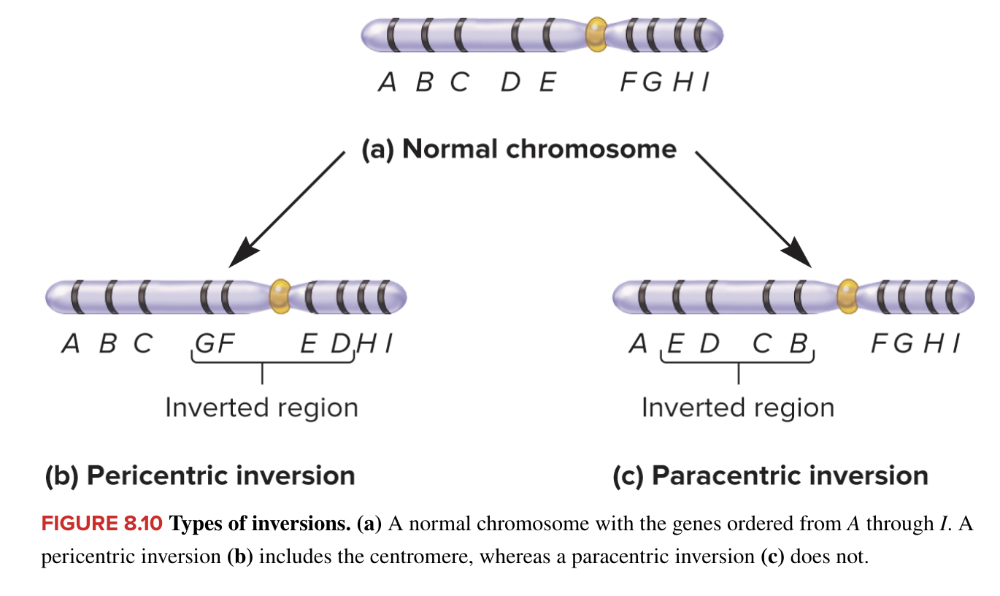
pericentric; paracentric
An inversion that has inactivated the gene for the blood clotting protein factor VIII is known to cause the disease ______.
Multiple choice question.
beta thalassemia
hemophilia type A
sickle cell anemia
erythropoietic porphyria
hemophilia type A
In humans, about ____% of individuals possess inversions that can be seen by light microscopy.
2
A gene has been moved from the short arm of chromosome 1 to the long arm of chromosome 5, thus causing a change in the phenotype associated with that gene. This is an example of a(n) ______ effect.
Multiple choice question.
nondisjunction
aneuploidy
position
position
What proportion of inversions cause phenotypic consequences?
Multiple choice question.
The vast majority
About 50% of them
Very few of them
Very few of them
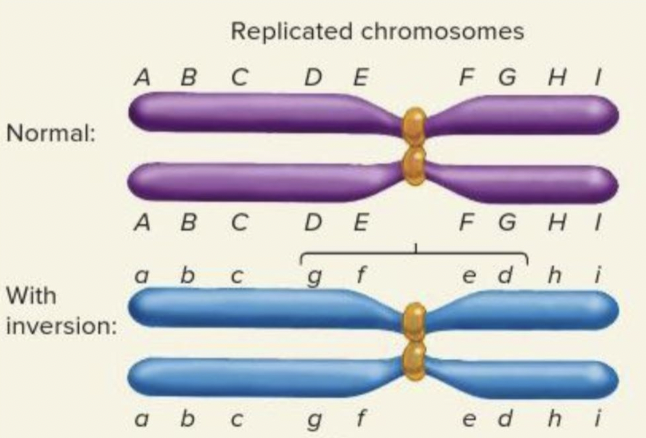
An individual with the following chromosomes is best described as a(n) ______.
Multiple choice question.
translocation homozygote
inversion heterozygote
inversion homozygote
translocation heterozygote
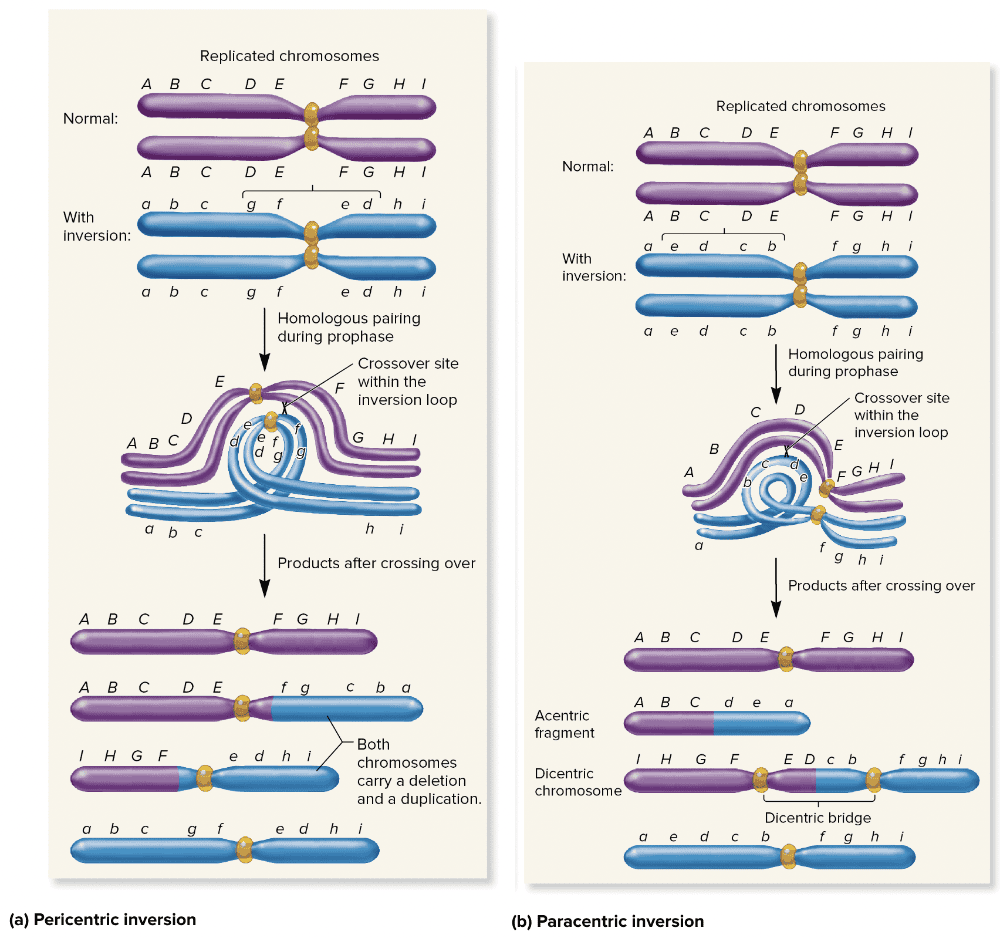
inversion heterozygote
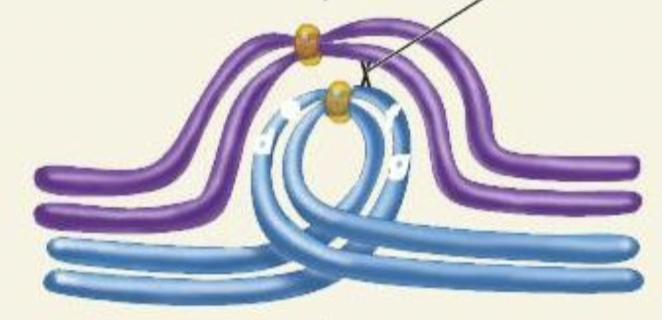
This figure illustrates what phenomenon?
Multiple choice question.
A translocation loop which occurs in prophase II of meiosis in a translocation heterozygote
An inversion loop which occurs in prophase I of meiosis in an inversion heterozygote
A translocation loop which occurs in prophase I of meiosis in a translocation heterozygote
An inversion loop which occurs in prophase II of meiosis in an inversion heterozygote

An inversion loop which occurs in prophase I of meiosis in an inversion heterozygote
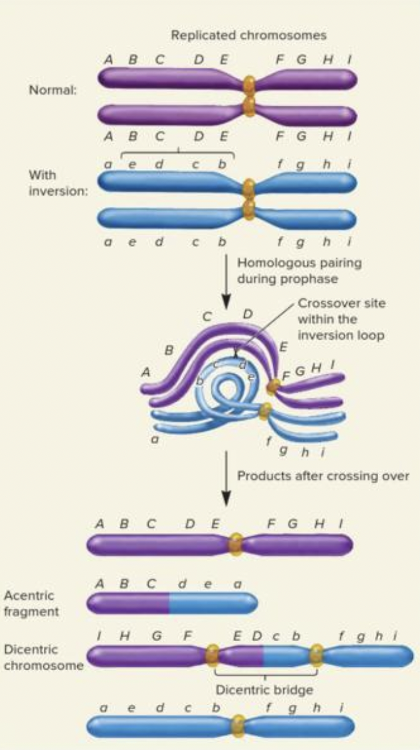
This figure shows the outcome of a crossover that occurred during prophase I in an individual carrying a ______ inversion.
Multiple choice question.
pericentric
paracentric

paracentric
What percent of the human population contains inversions observable with light microscopy?
Multiple choice question.
About 25%
About 0.1%
About 10%
About 2%
About 2%
A piece of a chromosome that has lost its centromere is called a(n) ____ fragment.
acentric
A chromosome that possesses two centromeres is called a(n) ____ chromosome.
dicentric
An individual that carries one copy of a normal chromosome and one copy that contains an inverted segment is described by the term ____ ____.
inversion heterozygote
During meiosis I in an inversion heterozygote, the normal chromosome and inversion chromosome can synapse via the formation of a(n) ____ ____. This allows the homologous genes on both chromosomes to align next to each other, regardless of the size of the inverted segment.
inversion loop
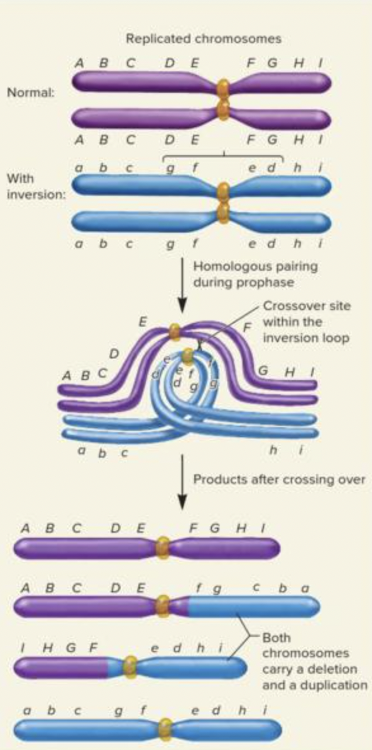
This figure represents the outcome of a crossover involving a(n) ______.
Multiple choice question.
simple translocation in a translocation heterozygote
reciprocal translocation in a translocation heterozygote
pericentric inversion in an inversion heterozygote
paracentric inversion in an inversion heterozygote

pericentric inversion in an inversion heterozygote
The region of a chromosome that links two centromeres is called a(n) ____ ____.
dicentric bridge
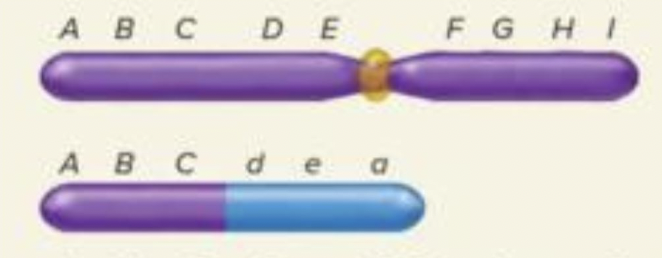
Compared to the chromosome on top, the one on the bottom is best described as a(n) ______ fragment.
Multiple choice question.
holocentric
pseudocentric
dicentric
acentric
acentric
The ends of a eukaryotic chromosome are called ____.
telomeres

This figure shows a(n) ______ chromosome.
Multiple choice question.
dicentric
holocentric
telocentric
acentric
dicentric
Chromosome breakage and abnormal re-attachment is one mechanism that causes a(n) ____ ____. Another mechanism involves a crossover between nonhomologous chromosomes.
reciprocal translocation
Reciprocal translocations are also called ____translocations, because they do not change the total amount of genetic material.
balanced
Individuals with reciprocal translocations are at risk of having offspring with ____ translocations, having chromosomes that carry duplications and/or deletions.
unbalanced

The bracket in this figure highlights a dicentric ______.
Multiple choice question.
domain
loop
karyotype
bridge
bridge
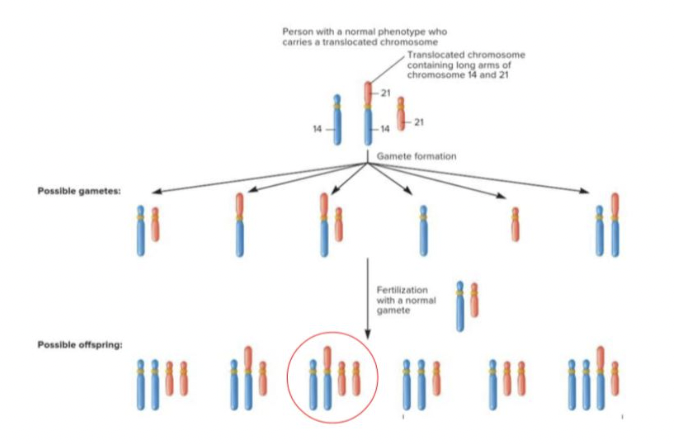
In this figure, the blue and red chromosomes represent chromosome numbers 14 and 21, respectively. An individual with the circled chromosomes has ____ ____ syndrome.
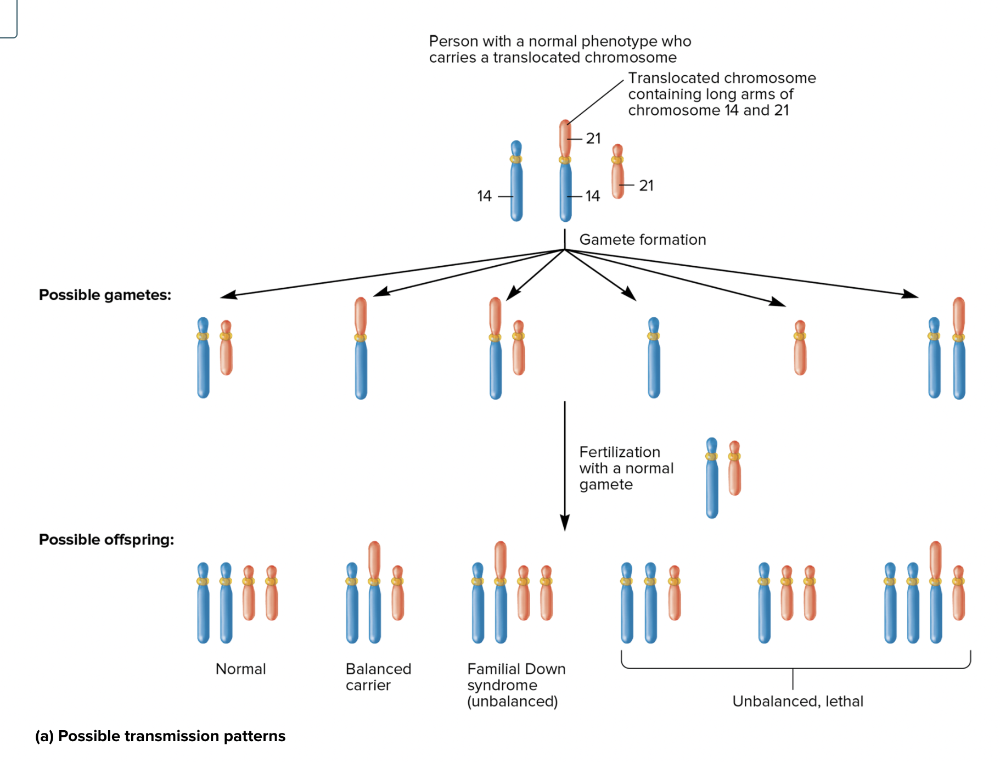
familial down
Telomeres are ______.
Multiple choice question.
sequences of DNA that are rich in protein-encoding genes
repeated sequences of DNA that bind microtubules during mitosis
repeated sequences of DNA that are found at the end of chromosomes
sequences of DNA that initiate replication during interphase
repeated sequences of DNA that are found at the end of chromosomes
A _____ translocation occurs when two nonhomologous acrocentric chromosomes lose their short arms and fuse to form a large single chromosome.
Multiple choice question.
Robertsonian
reciprocal
balanced
telocentric
Robertsonian
Select all that apply
Which of the following can cause reciprocal translocations to occur?
Multiple select question.
Crossover between nonhomologous chromosomes
Chromosomal breakage and DNA repair
Chromosome loss during meiosis II
Nondisjunction during meiosis I
Crossover between homologous chromosomes
Crossover between nonhomologous chromosomes
Chromosomal breakage and DNA repair
Translocations that do not alter the amount of genetic material in an individual are known as ______ translocations.
Multiple choice question.
symmetric
centric
equivalent
balanced
balanced
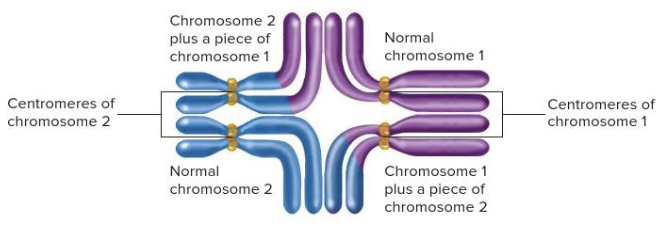
This figure illustrates a structure called a(n) ____ ____.
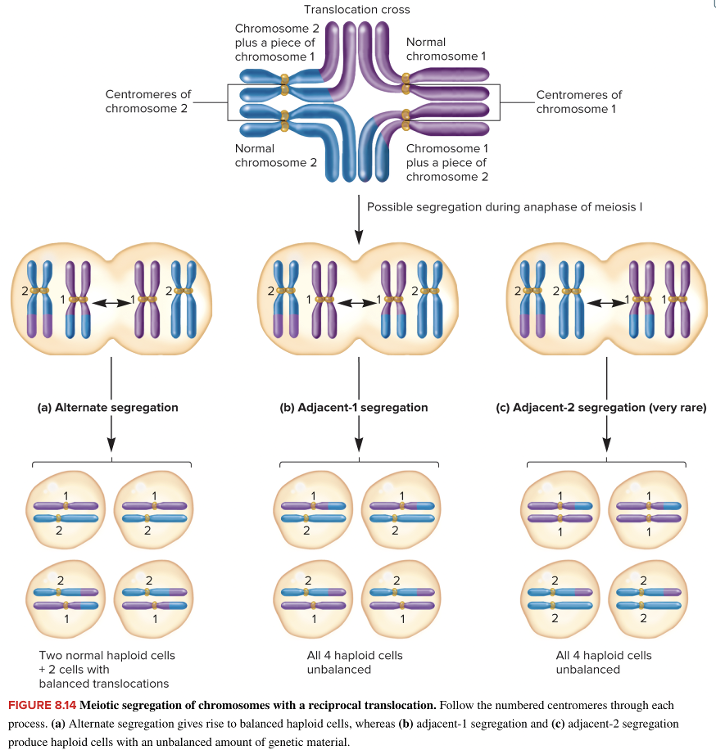
translocation cross
Translocations that involve a change in the total amount of genetic material in an individual are known as ______ translocations.
Multiple choice question.
unbalanced
acentric
disproportionate
asymmetric
unbalanced
Individuals with familial Down syndrome carry an abnormal chromosome complement as a result of a translocation. Individuals with this type of Down syndrome would have ______.
Multiple choice question.
two copies of chromosome 21 and a chromosome that is a fusion between chromosome 14 and 21
three entire copies of chromosome 21
a copy of chromosome 21 and a chromosome that is a fusion between chromosome 14 and 21
a copy of chromosome 21 and two copies of a chromosome that is a fusion between chromosome 14 and 21
two copies of chromosome 21 and a chromosome that is a fusion between chromosome 14 and 21
Match the type of meiotic segregation of a reciprocal translocation to its correct description.
Instructions
Alternate segregation
Adjacent-1 segregation
Adjacent-2 segregation
Centromeres do not segregate as they should; one daughter cell receives both copies of the centromere on chromosome one, and the other receives both copies of the centromere on chromosome 2; four gametes are genetically unbalanced
Adjacent chromosomes (one of each type of centromere) sort into the same cell; four gametes are genetically unbalanced
Chromosomes on opposite sides of the translocation cross segregate into the same cell; two gametes have normal chromosomes; two have balanced translocations
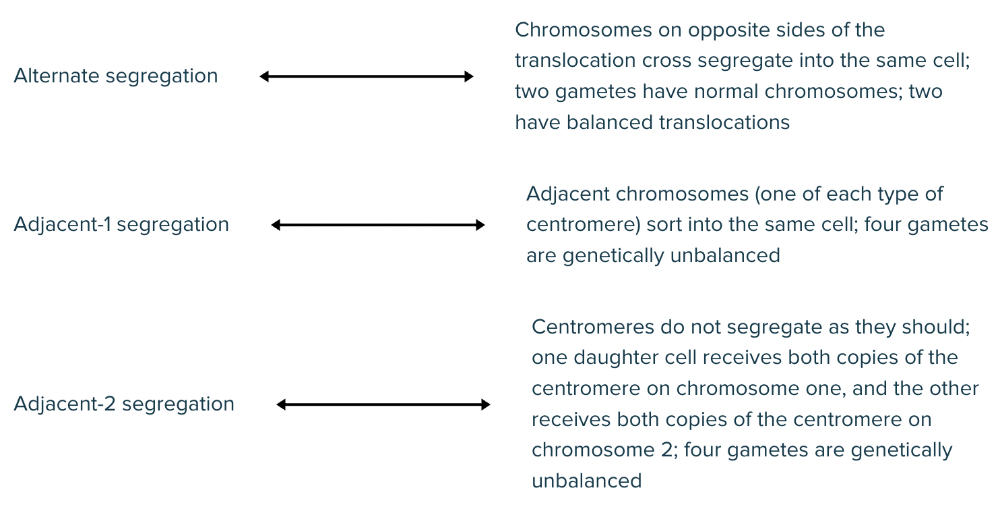
1. alternate segregation- chromosomes on opposite sides of the
translocation cross segregate into the same cell; two gametes have
normal chromosomes; two have balanced translocations
2. Adjacent
-1 - segregation - Adjacent chromosomes (on of each type of
centromere) sort into the same cell; four gametes are genetically
unbalanced
3. Adjacent 2-segregation - Centromeres do not
segregate as they should; one daughter cell received both copies of
the centromere on chromosome one, and the other receives both copies
of the centromere on chromosome 2; four gametes are genetically unbalanced
A Robertsonian translocation occurs when two ______ chromosomes lose their short arms and fuse to form a large single chromosome.
Multiple choice question.
homologous acrocentric
homologous telocentric
nonhomologous acrocentric
nonhomologous telocentric
nonhomologous acrocentric
What change in chromosome structure may lead to semisterility?
Multiple choice question.
Reciprocal translocation
Paracentric inversion
Simple translocation
Pericentric inversion
Reciprocal translocation
Chromosome breakage and abnormal re-attachment is one mechanism that causes a(n) ____ ____. Another mechanism involves a crossover between nonhomologous chromosomes.
reciprocal translocation
During meiosis I in an individual carrying a reciprocal translocation, the homologous chromosomes synapse with each other via the formation of a structure that contains four pairs of sister chromatids. This unusual structure is called a translocation ______.
Multiple choice question.
domain
loop
bridge
cross
cross
A(n) ____ organism is one with a chromosome number that is an exact multiple of a chromosome set.
euploid
In an individual with a reciprocal translocation, meiotic segregation can occur in different patterns: _______ segregation gives rise to balanced haploid cells, whereas ________ produces haploid cells with an unbalanced amount of genetic material.
Multiple choice question.
adjacent-1 ; alternate
adjacent-1 ; adjacent-2
alternate ; adjacent-1
adjacent-2 ; adjacent-1
alternate ; adjacent-1
An organism that has three sets of chromosomes is called a(n) ____, while one with four sets is called a(n) ____.
triploid; tetraploid
In individuals carrying a reciprocal translocation, alternate and adjacent-1 segregation patterns typically occur in equal frequency. Since the gametes produced by adjacent-1 segregation are not viable, this leads to a decrease in the reproductive potential of the individual -- a condition called ____.
semisterility
Polyploidy is best defined as the presence of ______.
Multiple choice question.
two or more copies of a chromosome
three or more sets of chromosomes
three or more copies of a chromosome
two or more sets of chromosomes
three or more sets of chromosomes
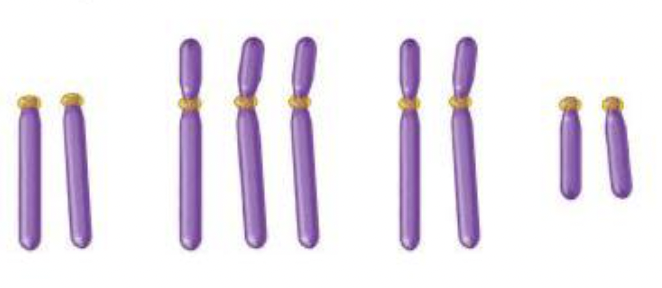
The diploid chromosome number of fruit flies is 8. The condition exhibited in this figure is
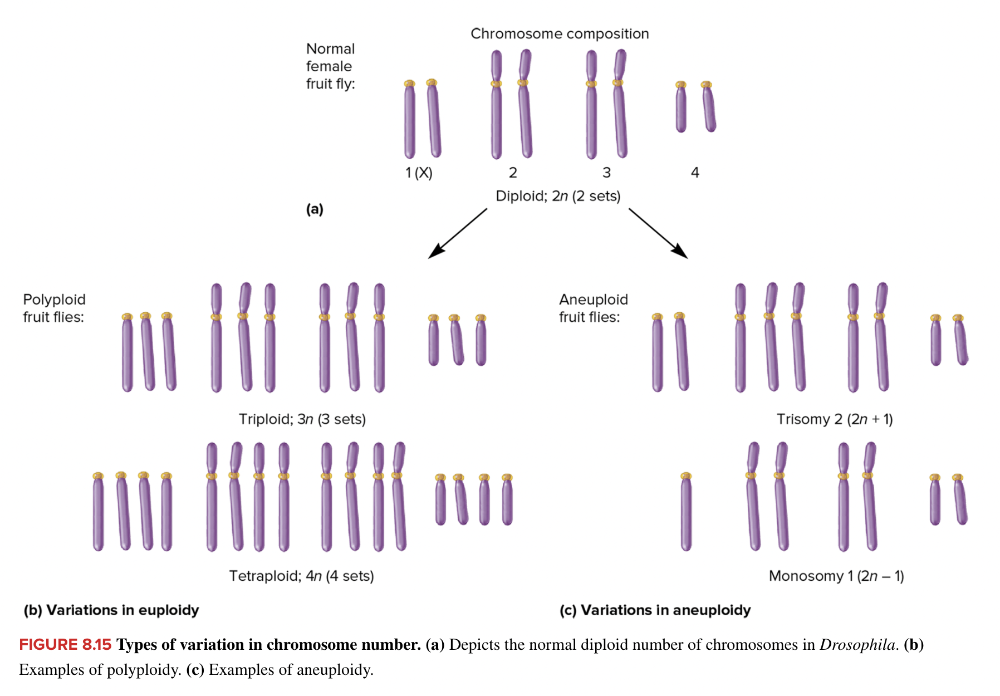
trisomy, aneuploidy, or trisomic
In a particular plant species, individuals can be diploid, triploid, or tetraploid. All of these organisms are said to be ______.
Multiple choice question.
euploid
polyploid
heteroploid
aneuploid
euploid
Changes in the number of individual chromosomes such that the total number of chromosomes is not an exact multiple of a set results in a condition called ____.
aneuploid
In organisms that are normally diploid, a trisomic individual is designated
Multiple choice question.
2n - 1.
3n.
2n + 1.
3n - 1.

2n + 1.
In Drosophila melanogaster, 2n = 8. A triploid fly would have ______ chromosomes, while a tetraploid fly would contain ______ chromosomes.
Multiple choice question.
12 ; 16
12 ; 24
10 ; 12
16 ; 24
16 ; 32
12 ; 16
An organism that has only one copy of a particular chromosome instead of the normal two copies is said to be ____.
monosomic, monosomy, or monosome
A(n) ____ organism is one that contains three or more sets of chromosomes.
polyploid
Aneuploidy causes an abnormal phenotype due to ______.
Multiple choice question.
an abnormal crossover in altered chromosomes
balance in the gene products
an imbalance of gene products
an imbalance of gene products

In fruit flies, 2n = 8. This figure shows the chromosome complement of a(n) ______ fly.
Multiple choice question.
triploid
aneuploid
tetrasomic
trisomic
triploid
What percentage of spontaneous abortions are due to changes in chromosome number?
Multiple choice question.
About 1%
About 75%
About 50%
About 25%
About 10%
About 50%
______ is the gain or loss of individual chromosomes to or from a complete set.
Multiple choice question.
Euploidy
Autosomy
Heterosomy
Alloploidy
Aneuploidy
Aneuploidy
In humans, the most common disorders involving abnormalities in the number of autosomes are trisomies of chromosomes ____, ____, and ____.
13; 18; 21
An organism that has three copies of a particular chromosome instead of the normal two copies is said to be
trisomy
Spontaneously aborted human embryos have been found to contain every trisomy except that of chromosome ____.
1
In organisms that are normally diploid, a monosomic individual is designated ______.
Multiple choice question.
n + 1
2n - 1
1n
n - 1

2n - 1
Match the syndrome to its appropriate description.
Trisomy 13
Trisomy 18
Trisomy 21
Down syndrome
Edwards syndrome
Patau syndrome

Trisomy 13: Patau syndrome
Trisomy 18: Edwards syndrome
Trisomy 21: Down syndrome
In comparison to a normal diploid cell, a cell that is trisomic would produce up to ______ of the protein product of the gene found in three copies. Therefore, an imbalance occurs between the level of expression of this gene versus the ones that are normally found in pairs.
Multiple choice question.
150%
50%
300%
200%
100%
150%
In humans, an individual with Klinefelter syndrome has a sex chromosome composition of ______.
Multiple choice question.
XXY
XXX
XO
XYY
XXY
True or false: In humans, about one-fifth of all spontaneous abortions are caused by abnormalities in the number of chromosomes.
True
False
False
The three most common autosomal trisomies in humans are those involving what chromosomes?
Multiple select question.
Chromosome 5
Chromosome 21
Chromosome 13
Chromosome 1
Chromosome 18
Chromosome 15
Chromosome 21
Chromosome 13
Chromosome 18
Which of the following trisomies is so lethal that it does not allow embryo implantation in the uterus?
Multiple choice question.
Trisomy 3
Trisomy 16
Trisomy 1
Trisomy X
Trisomy 22
Trisomy 1
Unlike trisomy for autosomes, trisomy X is often without serious phenotypic consequences. This is due to the fact that the additional X chromosome is converted to an inactive ____ ____ in the somatic cells of the adult.
Barr body
Multiple Choice Question
In humans, trisomy 13 is also known as ______, while trisomy 18 is called ______.
Marfan syndrome ; Lejeune syndrome
Patau syndrome ; Edwards syndrome
Lejeune syndrome ; Marfan syndrome
Edwards syndrome ; Patau syndrome

Patau syndrome ; Edwards syndrome
Of the following, which is the most likely to have a child with Down syndrome?
Multiple choice question.
A male who was 46 years when he became a father
A female who was 23 years old when she gave birth
A female who was 46 years old when she gave birth
A male who was 23 years when he became a father
A female who was 46 years old when she gave birth
A person with 44 autosomes, one X chromosome, and no Y chromosome is said to have ____ syndrome.
turner
Nondisjunction occurs when chromosomes do not ______.
Multiple choice question.
replicate properly during interphase
condense efficiently during interphase
recombine efficiently during meiosis
separate properly during meiosis
separate properly during meiosis
Individuals with Down syndrome have three copies of chromosome 21. The extra copy is most likely to be due to ____ during meiosis I in the oocyte.
nondisjunction
Trisomy X typically does not cause phenotypic abnormalities because ______.
Multiple choice question.
the X chromosome contains genes that are not essential for survival
all additional X chromosomes are converted to Barr bodies
the X chromosome is very small and does not contain a lot of genes
all additional X chromosomes are converted to polar bodies
all additional X chromosomes are converted to Barr bodies
Select all that apply
The haplodiploid system of sex determination is used by which of the following?
Multiple select question.
Birds
Ants
Bees
Sharks
Grasshoppers
Ants
Bees
Abnormalities in chromosome number in humans rise with an increase in the ____ of either parent.
age
Where has polyploidy been discovered?
Multiple choice question.
In both plants and animals
In neither plants nor animals
In plants only
In animals only
In both plants and animals
In humans, an individual with Klinefelter syndrome has a sex chromosome composition of ______.
Multiple choice question.
XXY
XO
XXX
XYY
XXY
A diploid organism that has some polyploid cells is exhibiting ____.
endopolyploidy
The failure of chromosomes to segregate properly during mitosis or meiosis is called ____.
nondisjunction
A giant chromosome consisting of many identical copies of a chromosome lying next to each other in parallel is known as a(n) ____ chromosome.
polytene
The most common cause of trisomy 21 is nondisjunction during ______ in the ______.
Multiple choice question.
meiosis I; mother
meiosis II; father
meiosis II; mother
meiosis I; father
meiosis I; mother
In bees, ______.
Multiple choice question.
both males and females are haploid
males are haploid, while females are diploid
females are haploid, while males are diploid
both males and females are diploid
males are haploid, while females are diploid
The chromosomes of a polytene chromosome aggregate at a central point called the ____.
chromocenter
True or false: Polyploidy is tolerated in plants. However, it is a lethal condition in all animals.
False
Polyploidy is commonly found in species of ______.
Multiple choice question.
bacteria
vertebrate animals
plants
invertebrate animals
plants
Liver cells of humans may be triploid (3n), tetraploid (4n), or even octaploid (8n). This phenomenon is best described as ______.
Multiple choice question.
polysomy
endopolyploidy
allopolyploidy
polyembryony
endopolyploidy
Strawberries exist ______.
Multiple choice question.
as different species: diploid, triploid, or tetraploid
as two species: diploid or triploid
as different species: diploid, tetraploid, or even octaploid
as a single species: tetraploid
as different species: diploid, tetraploid, or even octaploid
The polytene chromosomes of Drosophila ______.
Multiple choice question.
arise when chromosomal duplication occurs without cell division
are large chromosomes that play a role in sex determination
arise when cell division occurs without chromosomal duplication
are small chromosomes that can fuse end to end forming a longer chromosome
arise when chromosomal duplication occurs without cell division
Which of the following individuals will have the most trouble in producing functional gametes during meiosis?
Multiple choice question.
Triploid with 30 total chromosomes
Tetraploid with 60 total chromosomes
Diploid with 6 total chromosomes
Tetraploid with 48 total chromosomes
Triploid with 30 total chromosomes
Polytene chromosomes appear to be bound to each other at the ______.
Multiple choice question.
centromere
chromomere
centrosome
chromocenter
chromocenter
In a triploid plant, the probability that meiosis will produce a gamete that is perfectly haploid or diploid is _______, where n is the number of chromosomes in a set. Thus, the high probability of aneuploid gametes makes triploid plants sterile.
Multiple choice question.
(1/2)n+1
(1/2)n
(1/2)n-1
(1/2)2n
(1/2)n-1
Which of the following statements about polyploidy is true?
Multiple choice question.
It is equally common in animals and in plants
It is more common in plants than in animals
It is more common in animals than in plants
It is more common in plants than in animals
Cultivated wheat, Triticum aestivum, is a ______ that was derived from ______ species of grasses.
Multiple choice question.
hexaploid ; two different triploid
tetraploid ; two different diploid
hexaploid ; three different diploid
tetraploid ; four different haploid
hexaploid ; three different diploid
Sterility can be a desirable trait from an agricultural perspective since it may result in a fruit that is ____.
seedless
Multiple Choice Question
Polyploid plants that have an odd number of chromosome sets are usually ______, and those with an even number of chromosome sets are usually ______.
Multiple choice question.
sterile ; sterile
sterile ; fertile
fertile ; fertile
fertile ; sterile
sterile ; fertile
The term meiotic ____ refers to the failure of chromosomes to separate normally during meiosis. This results in haploid cells that have too many or too few chromosomes.
nondisjunction
Select all that apply
When does nondisjunction typically occur (choose all that apply)?
Multiple select question.
Cytokinesis of meiosis I
Telophase of meiosis II
Anaphase of meiosis II
Telophase of meiosis I
Anaphase of meiosis I
Anaphase of meiosis II
Anaphase of meiosis I
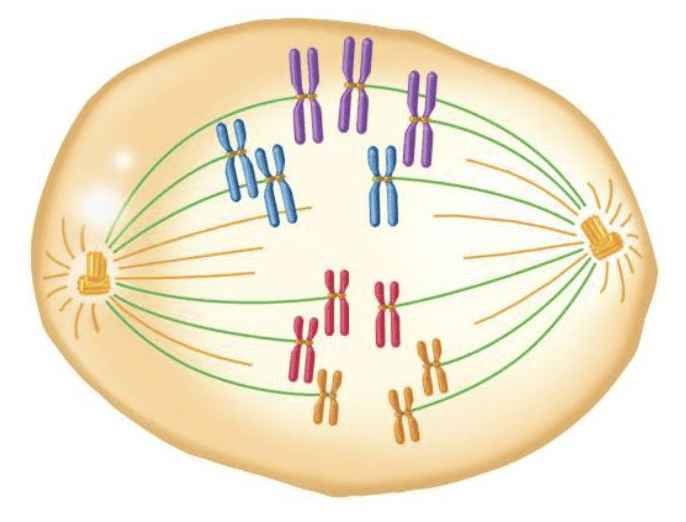
This figure shows anaphase I of meiosis in a ______ individual containing ______ chromosomes.
Multiple choice question.
triploid; three sets of four
hexaploid; six sets of two
tetraploid; four sets of three
diploid; two sets of six
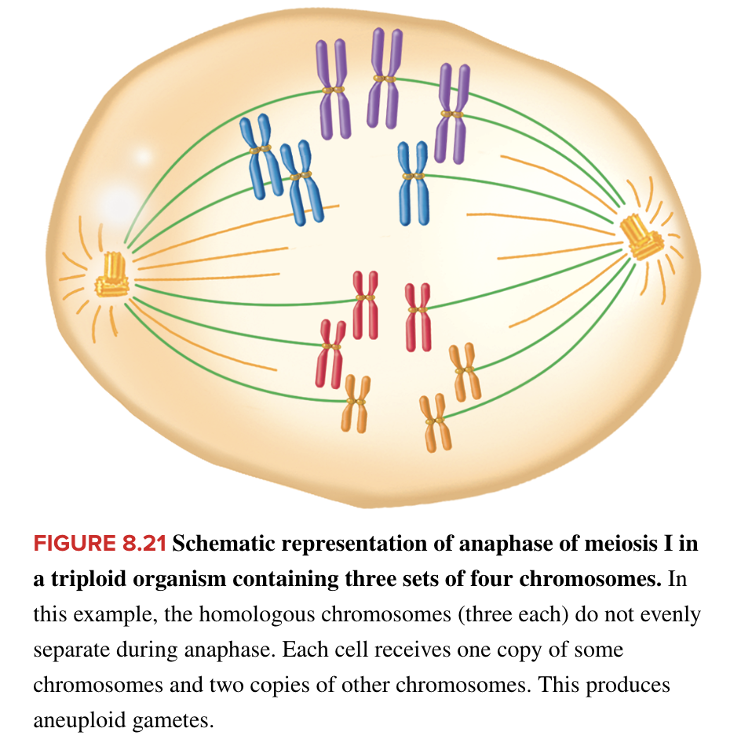
triploid; three sets of four
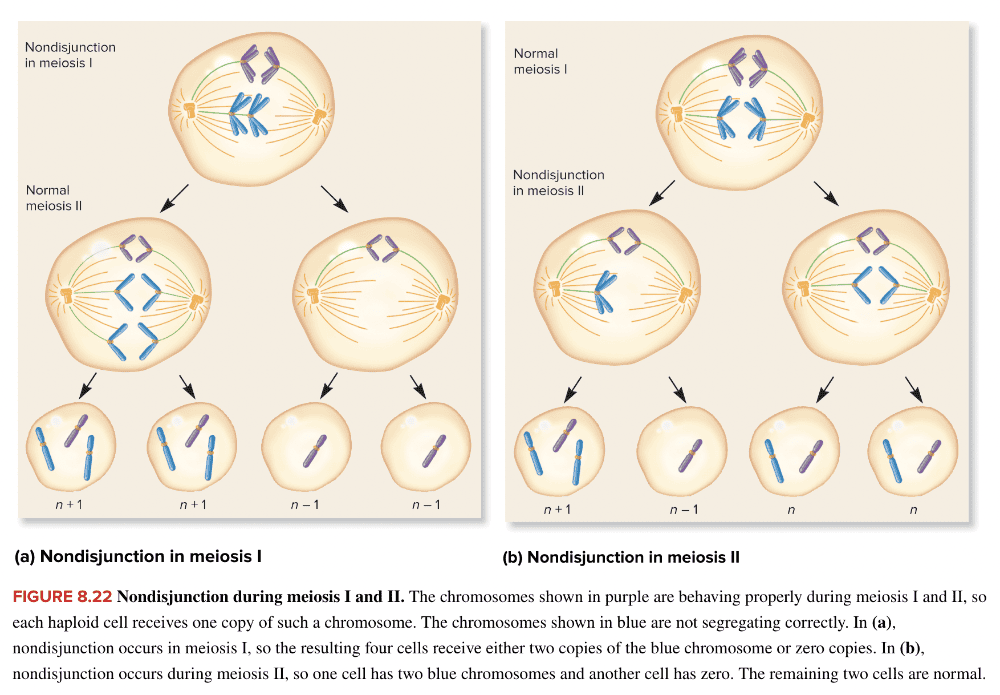
If a pair of homologous chromosomes undergoes nondisjunction during meiosis I, what will be the chromosome number of the four resulting gametes? Assume meiosis II is normal.
Multiple choice question.
n - 1; n - 1; n; n
n + 1; n - 1; n - 1; n
n + 1; n + 1; n; n
n + 1; n - 1; n; n
n + 1; n + 1; n - 1; n - 1
n + 1; n + 1; n - 1; n - 1
The house mouse Mus musculus has a diploid chromosome number of 40. Suppose that the first meiotic division of a germ cell is normal, but a single dyad in one of the two daughter cells undergoes nondisjunction in meiosis II. How many chromosomes would be present in each of the four gametes that result from that meiosis?
Multiple choice question.
20, 20, 21, 19
22, 20, 18, 16
10, 10, 12, 8
21, 21, 19, 19
12, 12, 8, 8
20, 20, 21, 19
A triploid plant is advantageous in agriculture because it is often ______.
Multiple choice question.
fertile
disease-resistant
seedless
pest-resistant
seedless
If a sperm carrying an extra chromosome fertilizes a normal egg, the zygote that is produced will be ______.
Multiple choice question.
monosomic
tetrasomic
trisomic
disomic
trisomic
Improper separation of chromosomes can occur after fertilization in one of the body's somatic cells. This mechanism is referred to as mitotic ____.
nondisjunction
Complete nondisjunction during the first meiotic division would result in which of the following gametes at the end of meiosis II?
Multiple choice question.
Four haploid gametes
Two diploid gametes
Four aneuploid gametes
Two diploid gametes and two haploid gametes
Two diploid gametes
Nondisjunction occurs during what stage of meiosis?
Multiple choice question.
Anaphase I but not anaphase II
Neither anaphase I nor anaphase II
Anaphase II but not anaphase I
Either anaphase I or anaphase II
Either anaphase I or anaphase II
During mitosis of a particular diploid cell, a single chromosome undergoes nondisjunction. What will be the chromosome number in the resulting daughter cells?
Multiple choice question.
n + 1, n - 1
2n, 2n - 1
2n, n
2n + 1, 2n - 1
2n + 1, 2n
2n + 1, 2n - 1
The hypothetical organism Sllub adirolfhtuos has a diploid chromosome number of 56. Suppose that one of the chromosome pairs fails to disjoin properly during meiosis I. How many chromosomes will be present in each of the four gametes that result from that meiosis? Assume meiosis II is normal.
Multiple choice question.
12, 12, 16, 16
28, 28, 0, 0
28, 28, 27, 29
27, 27, 29, 29
12, 16, 14, 14
27, 27, 29, 29
In a particular cell undergoing meiosis, the first meiotic division is normal, but a chromosome undergoes nondisjunction during meiosis II. What will be the chromosome number of the four resulting gametes?
Multiple choice question.
n + 1; n + 1; n; n
n - 1; n - 1; n; n
n + 1; n - 1; n - 1; n
n + 1; n - 1; n; n
n + 1; n + 1; n - 1; n - 1

n + 1; n - 1; n; n
Assume nondisjunction occurs in meiosis II in oogenesis. If the resulting gametes are fertilized by normal sperm, what types of zygotes can be produced?
Multiple choice question.
Trisomic only
Disomic and trisomic
Monosomic and disomic
Monosomic and trisomic
Monosomic, disomic, and trisomic
Monosomic, disomic, and trisomic
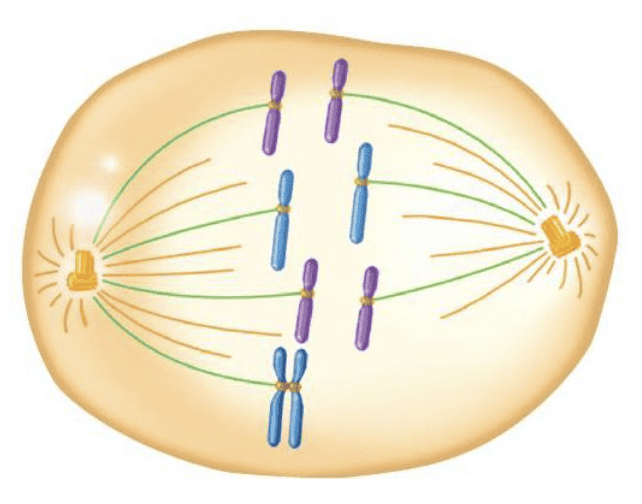
Consider a cell that is 2n = 4. This figure represents what event?
Multiple choice question.
Nondisjunction during meiosis I
Nondisjunction during mitosis
Chromosome loss during mitosis
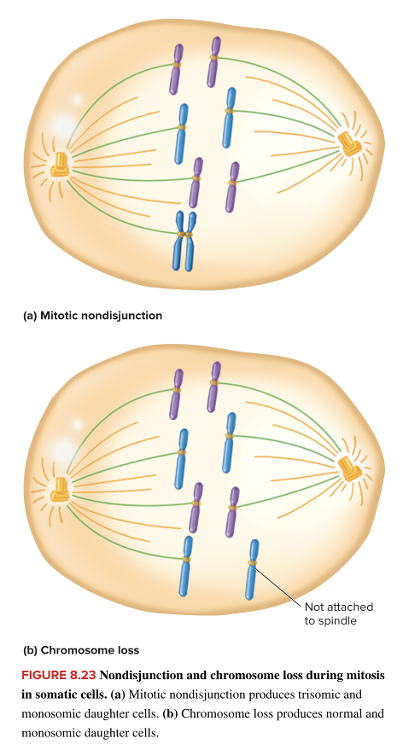
Nondisjunction during mitosis
In meiosis, if all of the chromosomes fail to separate normally, and end up migrating to one of the two daughter cells, the result is that all four cells are abnormal. This event is known as ____.
complete nondisjunction
Mitotic nondisjunction in a diploid cell produces ______.
Multiple choice question.
a trisomic and a disomic daughter cell
two nullisomic daughter cells
a disomic and a nullisomic daughter cell
two monosomic daughter cells
a trisomic and a monosomic daughter cell
a trisomic and a monosomic daughter cell
Chromosome loss during mitosis of a diploid cell produces ______.
Multiple choice question.
a trisomic and a nullisomic daughter cell
two monosomic daughter cells
a disomic and a nullisomic daughter cell
two nullisomic daughter cells
a normal and a monosomic daughter cell
a normal and a monosomic daughter cell
Mosaics are most likely caused by ______.
Multiple choice question.
nondisjunction during meiosis I
nondisjunction during mitosis
nondisjunction during meiosis II
Robertsonian translocations
nondisjunction during mitosis
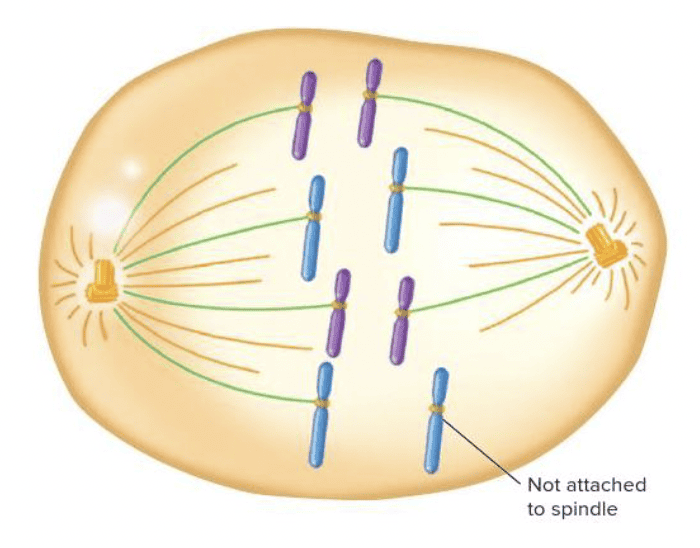
A cell has a normal diploid chromosome number of 4. The phenomenon shown in this diagram is ______.
Multiple choice question.
nondisjunction during mitosis
nondisjunction during meiosis I
chromosome loss during mitosis

chromosome loss during mitosis
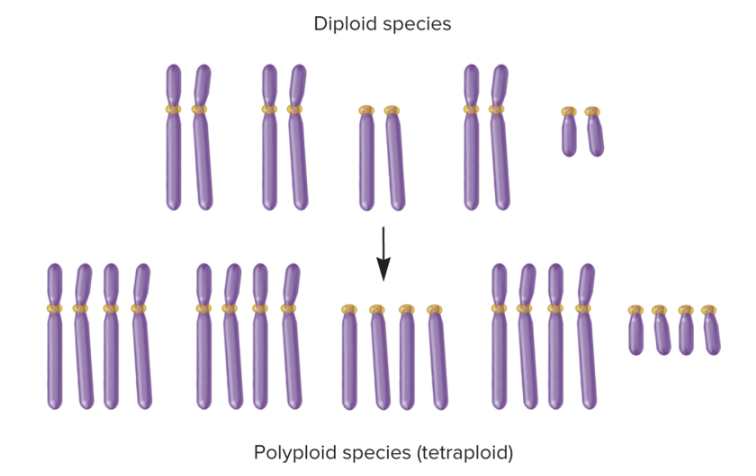
This figure best illustrates the condition of ______.
Multiple choice question.
allopolyploidy
autopolyploidy
aneuploidy
endopolyploidy
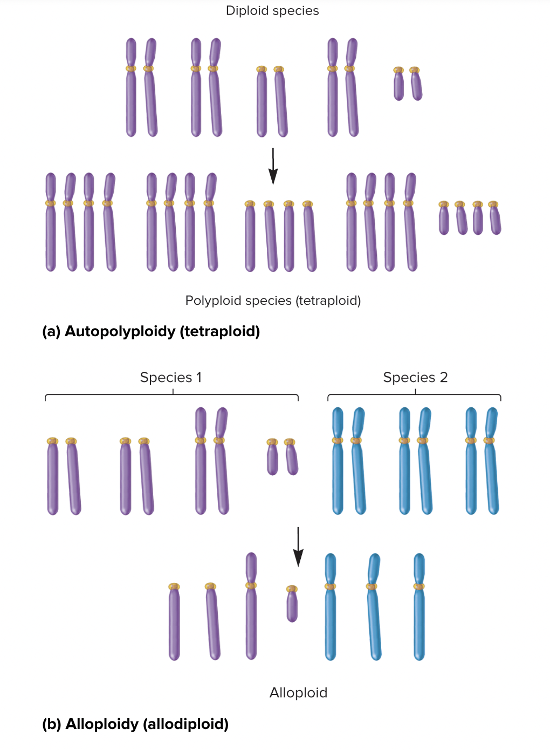
autopolyploidy
Complete nondisjunction during the first meiotic division would result in which of the following gametes at the end of meiosis II?
Multiple choice question.
Four haploid gametes
Two diploid gametes and two haploid gametes
Four aneuploid gametes
Two diploid gametes
Two diploid gametes
An allodiploid refers to an organism that has ______.
Multiple choice question.
one set of chromosomes from two different species
two sets of chromosomes from the same species
one subset of cells that is monoploid, and another that is polyploid
one subsets of cells that is euploid, and another that is aneuploid
one set of chromosomes from two different species
During mitosis of a particular diploid cell, a chromosome loss event occurs. What will be the chromosome number in the resulting daughter cells?
Multiple choice question.
2n, n
n + 1, n - 1
2n + 1, 2n
2n + 1, 2n - 1
2n, 2n - 1
2n, 2n - 1
Nondisjunction events that occur during mitosis, produce a subset of cells that are genetically different from those of the rest of the organism. This condition is called ____.
mosaicism
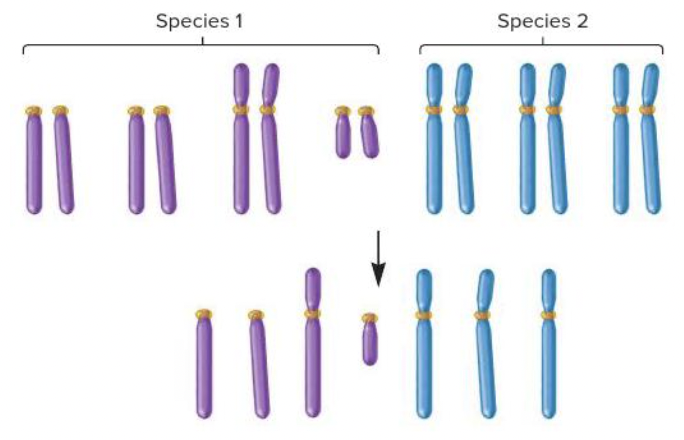
This karyotype depicts the ______ chromosome of an ______.
Multiple choice question.
homologous; autodiploid
homeologous; allodiploid
homeologous; autodiploid
homologous; allodiploid
homeologous; allodiploid
An individual that has multiple sets of chromosomes from the same species is best described as a(n) ______.
Multiple choice question.
homopolyploid
endopolyploid
allopolyploid
autopolyploid
autopolyploid
Species A and species B are closely related. Both are diploid with A having 2n = 12 and B having 2n = 14. How many chromosomes will an allotetraploid have?
Multiple choice question.
52
28
24
26
26
An organism that has one set of chromosomes from two different species is best described as a(n) ______.
Multiple choice question.
heterodiploid
allodiploid
autodiploid
pseudodiploid
allodiploid
An allotetraploid possesses which of the following?
Multiple choice question.
Four sets of chromosomes from one species.
Two sets of chromosomes from two different species.
One set of chromosomes from two different species.
One set of chromosomes from four different species.
Two sets of chromosomes from two different species.
The drug ____ is often used to promote polyploidy because it binds to the microtubule spindle apparatus and thus disrupts normal chromosome segregation during cell division.
colchicine
A male of species A is crossed with a female of species B. The offspring is best described as a(n) ______.
Multiple choice question.
aneuploid
allodiploid
endodiploid
autodiploid
allodiploid
Applying colchicine to a diploid plant may cause ____ ____ in a cell, which will form a tetraploid daughter cell. Such a tetraploid cell may continue to divide and produce a segment of the plant with more robust characteristics.
complete/mitotic nondisjunction
In a particular plant species, 2n = 12. How many chromosomes will an allotetraploid individual have?
Multiple choice question.
36
72
60
48
24
24
An organism that has at least two set of chromosomes from two or more different species is best described as a(n) ______.
Multiple choice question.
allopolyploid
exopolyploid
autopolyploid
heteropolyploid
allopolyploid
Which of the following is a commonly used agent for promoting polyploidy?
Multiple choice question.
Calmodulin
Colchicine
Safranin
Eosin
Colchicine
What happens when a diploid plant is treated with colchicine?
Multiple choice question.
The drug may cause complete nondisjunction, yielding tetraploid cells.
The drug may induce a lot of spontaneous mutations, causing the plant to die.
The drug may promote chromosomal rearrangements increasing the likelihood of tumors.
The drug may cause complete nondisjunction, yielding tetraploid cells.
